The elephant in the room: 4 ways to enhance a supportive virtual learning environment

It was the beginning of 2020 when the Swiss government decided that in-person classes could no longer be permitted. From one day to the next, classes became virtual. The impact of this decision on students and teachers was tremendous. As a lecturer during this time, one of the biggest struggles I had to face was the following:
“How to create a safe and supportive learning environment for my students.”
Let’s sketch the scene. You’re attending a private hospitality management school with students from all corners of the world. This implies a huge difference in cultural backgrounds, habits, and communication styles. When everyone is sitting together in a classroom, harmonizing all these different backgrounds is already quite a challenge. Imagine the added difficulties that arise when everyone is calling in from a different location, from a different time zone to attend a class, without ever having met in person.
How can I now, as a lecturer, contribute a create a safe and supportive learning environment? One where students feel they can ask questions, unashamed, where they can feel supported by each other and where taking risks to pursue your goals is encouraged? Sounds tricky, right?
Over the past months, I’ve had the chance to build some experience in this area, and I would love to share four best practices from my classroom:
- Address the elephant in the room
During one of my first virtual classes, it became quite clear that we needed to address the topic of a safe and supportive environment; cameras were turned off, response rates to questions were minimal. By acknowledging this fact openly in the classroom, we already began creating a safer environment. We had to discuss the fact that we’re not here just to absorb knowledge—we’re here to learn and to grow in the safest and most supportive way possible and yes, doing this in an online environment is weird at first, and even awkward. - Extensive welcome round in small groups
The conversation that came from addressing the elephant led me to realize that when you’ve never met your fellow students, it takes a lot of courage to hit that unmute bottom and to speak up in front of the whole class. In my opinion, it is therefore key to organize a welcome round, preferably starting in small groups. This way, the students can get to know at least a few of those they are studying alongside. I find it comparable to attending a network drink where you do not know anyone or attending one where you already know a few people superficially. In my view, most of us would feel a lot more comfortable in the second situation. With that, we’ve just created a handhold. - Group up
Digging deeper into the (not) speaking up issues. I find that working in smaller groups (3–4 people) on case studies works extremely well. Students feel more at ease and able to express their opinions when less people are listening. To bring this to the next step, I linked the small groups to a virtual “combating program.” This allowed the different groups to enter their answers into a program which then indicated whether they were correct. More importantly, the program indicated the progression of each group so that they were able to compare their scores to others. This brought out playful competitiveness in everyone, creating an atmosphere of fun and support. - Make sure you do not address someone unexpectedly
I’ll leave you with this: try NOT to address someone unexpectedly. I always made sure to ask students in a private chat if they would feel comfortable answering a specific question “in front” of the class. This way the student has the chance to (a) tell me that they’re not comfortable speaking up, (b) find time to figure out the solution, and (c) check with me if they have the right answer before speaking up.
Written by Wendy Cuijpers.
Add CEOWORLD magazine to your Google News feed.
Follow CEOWORLD magazine headlines on: Google News, LinkedIn, Twitter, and Facebook.
This report/news/ranking/statistics has been prepared only for general guidance on matters of interest and does not constitute professional advice. You should not act upon the information contained in this publication without obtaining specific professional advice. No representation or warranty (express or implied) is given as to the accuracy or completeness of the information contained in this publication, and, to the extent permitted by law, CEOWORLD magazine does not accept or assume any liability, responsibility or duty of care for any consequences of you or anyone else acting, or refraining to act, in reliance on the information contained in this publication or for any decision based on it.
Copyright 2024 The CEOWORLD magazine. All rights reserved. This material (and any extract from it) must not be copied, redistributed or placed on any website, without CEOWORLD magazine' prior written consent. For media queries, please contact: info@ceoworld.biz
SUBSCRIBE NEWSLETTER








